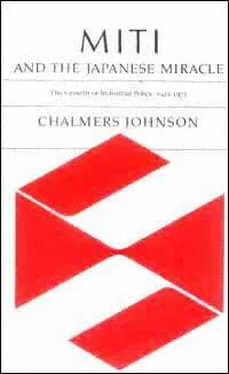Chalmers Johnson - MITI and the Japanese miracle
Здесь есть возможность читать онлайн «Chalmers Johnson - MITI and the Japanese miracle» весь текст электронной книги совершенно бесплатно (целиком полную версию без сокращений). В некоторых случаях можно слушать аудио, скачать через торрент в формате fb2 и присутствует краткое содержание. Год выпуска: 2007, Издательство: Stanford University Press, Жанр: Старинная литература, на английском языке. Описание произведения, (предисловие) а так же отзывы посетителей доступны на портале библиотеки ЛибКат.
- Название:MITI and the Japanese miracle
- Автор:
- Издательство:Stanford University Press
- Жанр:
- Год:2007
- ISBN:нет данных
- Рейтинг книги:3 / 5. Голосов: 1
-
Избранное:Добавить в избранное
- Отзывы:
-
Ваша оценка:
- 60
- 1
- 2
- 3
- 4
- 5
MITI and the Japanese miracle: краткое содержание, описание и аннотация
Предлагаем к чтению аннотацию, описание, краткое содержание или предисловие (зависит от того, что написал сам автор книги «MITI and the Japanese miracle»). Если вы не нашли необходимую информацию о книге — напишите в комментариях, мы постараемся отыскать её.
MITI and the Japanese miracle — читать онлайн бесплатно полную книгу (весь текст) целиком
Ниже представлен текст книги, разбитый по страницам. Система сохранения места последней прочитанной страницы, позволяет с удобством читать онлайн бесплатно книгу «MITI and the Japanese miracle», без необходимости каждый раз заново искать на чём Вы остановились. Поставьте закладку, и сможете в любой момент перейти на страницу, на которой закончили чтение.
Интервал:
Закладка:
15


*
Ralf Dahrendorf's observation is to the point: "One of the decisive differences between industrialization in Germany and in the Anglo-Saxon countries lies in the role of banks, which themselves combined into mammoth financial empires at an early stage, carried by their credits and investments a considerable part of the weight of German industrialization, and at the same time facilitated the rapid growth of large industrial units."
Society and Democracy in Germany
(Garden City, N.Y.: Doubleday, 1967), p. 37.
Page 206
MITI helped rebuild the trading companies by issuing laws that authorized tax write-offs for the costs of opening foreign branches and for contingency funds against bad debt trade contracts, and as early as 1953 the ministry's powerful Industrial Rationalization Council (discussed below) called for the "keiretsu-ization" of trading companies and manufacturers. This meant, in practice, that MITI would assign an enterprise to a trading company if it did not already have an affiliation. Through its licensing powers and ability to supply preferential financing, MITI ultimately winnowed about 2,800 trading companies that existed after the occupation down to around 20 big ones, each serving a bank keiretsu or a cartel of smaller producers.
16
The bank groups were the successors to the old zaibatsu, and they came into being for the same reason that the old zaibatsu had been fostered in the Meiji erato concentrate scarce capital on key developmental projects. However, they differed from the old zaibatsu in that their internal organization was much more businesslike than the old family-centered empires, and they competed with each other much more vigorously.
This competition was ultimately caused by the nature of the banks' assets. As Abegglen and Rapp observe, "The financial risks associated with high debt levels are very much reduced in Japan by the fact that the central bank stands implicit guarantor of the debt positions of major Japanese companies."
17
It was this elimination of risk that above everything else made competition mandatory. And the risks for bank managers were even further reduced by powerful Finance Ministry controls over all interest rates and dividend rates, over the scope of a bank's operations, and over permission to open new branches, which meant that a banker really had only one thing to concentrate oncompetition for the expansion of a bank's share of loans and depositors. Under these conditions city banks did everything in their power to discover and come to the aid of growth industries and growth enterprises. Most important, each bank group had to have its entry in each new industry fostered by MITI or face being frozen out of the truly riskless sectors.
The result of these pressures and incentives was the famous "one setism" of high-growth Japan, a term meaning that each bank group acquired or created within it a full complement of companies covering all the government-designated growth industries, regardless of whether it made business sense to do so. This competition became the bane of MITI's existence during the 1960's, when, for example, the ministry fostered four petrochemical companies but soon found that five more were building their own complexes as fast and on as big a
Page 207
scale as the chosen leaders. Overproduction was inevitable, but this was not as serious a danger from the point of view of any one particular group (since MITI would have to organize a cartel to allocate market shares) as not being in on an important government-guaranteed industry at all.
Controlled though the Japanese economy surely was, Ichimada's modest efforts to expand the supply of capital during the dark days of 1950 thus led to much fiercer competition among big businesses than is common in other open economies dominated by oligopolies. Even the government's purely indicative "plans" of 1955 and after (discussed below) fed the competitive fires by revealing the industries that the government planned to commercialize over the coming termthat is, those in which the risks would be close to nil unless Japan itself went under. It is not at all surprising, therefore, or a reflection on the competence of government planners (as some scholars seem to think), that the targets for the designated priority sectors in all EPA plans have invariably been wildly overfulfilled.
18
The second tier of the industrial finance system, the government banks created by Ikeda, came into being to supplement the city banks at the point where the Bank of Japan had to place ultimate limits on how much it could lend. Shortly after the outbreak of the Korean War, Ichimada declared that the overloans had in fact reached their limits.
19
It would never have been possible, in any case, for the city banks alone to have supplied all the capital needed for the rehabilitation of Japan, particularly during the early period of capital shortage and particularly for the nonexporting but key infrastructure sectors of coal, steel, and electric power. These were the industries that the RFB had served, and Ikeda clearly recognized the need to create a replacement for it. His problem was that the Government Section of SCAP and Dodge both derided the RFB as the cause of hyperinflation, and some SCAP purists remained hostile to anything that smacked of the "national policy companies" of the prewar and wartime eras. The RFB's primary weakness was that a good portion of its funds had come straight out of the general account budget; Dodge had eliminated that source through his absolute requirement that Japan maintain balanced and even overbalanced budgets. What other sources of capital for a new bank were there?
There were two sources, primarily. The first was U.S. "counterpart funds" (
mikaeri shikin
)the yen proceeds from the sale in Japan of U.S. aid products; since Dodge's arrival, these proceeds had been carefully segregated into a special account rather than being combined with all foreign receipts, as was the case during the first half of
Page 208
the occupation. The second source of capital was the funds from the government-operated postal savings system, which were held in trust accounts by the Ministry of Finance. The postal savings system for small savers had existed since the Meiji era, and it had experienced a checkered career of alleged scandals and misuse by the government for various political ventures; for example, the Terauchi government in 1917 and 1918 had used the people's savings to redeem the notorious Nishihara loans to China. During the occupation SCAP had restricted government use of the postal savings accounts primarily to collateral for local bonds, but with the ending of inflation the accounts began to grow quite large as savers turned to the post offices rather than the private banks, which they did not fully trust. Ikeda wanted to open up the use of these funds to support the reindustrialization effort, and he wanted to see the counterpart monies spent for vital projects that the banks could not cover. He thus set out to negotiate these proposals with Dodge.
Ikeda first proposed an export bank, and this idea went down much easier with the Americans than his second onea new version of the RFB. The lack of adequate banking facilities to handle longer-term loans than were commercially available for the export of capital goods was having a retarding effect on trade, and SCAP therefore readily agreed to the creation of the Export Bank of Japan (law number 268 of December 15, 1950). The bank was established on December 28, 1950, and opened for business on February 1, 1951. The initial capital of ¥15 billion came from U.S. aid counterpart funds and from general account budget appropriations. The prime minister appointed the bank's president, and the Ministry of Finance supervised the bank. In April 1952, when the occupation ended, the government renamed it the Export-Import Bank of Japan and gave it the additional task of lending Japanese importers the funds they needed for advance payments for commodity imports approved by MITI. By 1958 the Export-Import Bank's capital account had risen to ¥38.8 billion, and its total loans outstanding amounted to ¥60.3 billion.
Читать дальшеИнтервал:
Закладка:
Похожие книги на «MITI and the Japanese miracle»
Представляем Вашему вниманию похожие книги на «MITI and the Japanese miracle» списком для выбора. Мы отобрали схожую по названию и смыслу литературу в надежде предоставить читателям больше вариантов отыскать новые, интересные, ещё непрочитанные произведения.
Обсуждение, отзывы о книге «MITI and the Japanese miracle» и просто собственные мнения читателей. Оставьте ваши комментарии, напишите, что Вы думаете о произведении, его смысле или главных героях. Укажите что конкретно понравилось, а что нет, и почему Вы так считаете.












